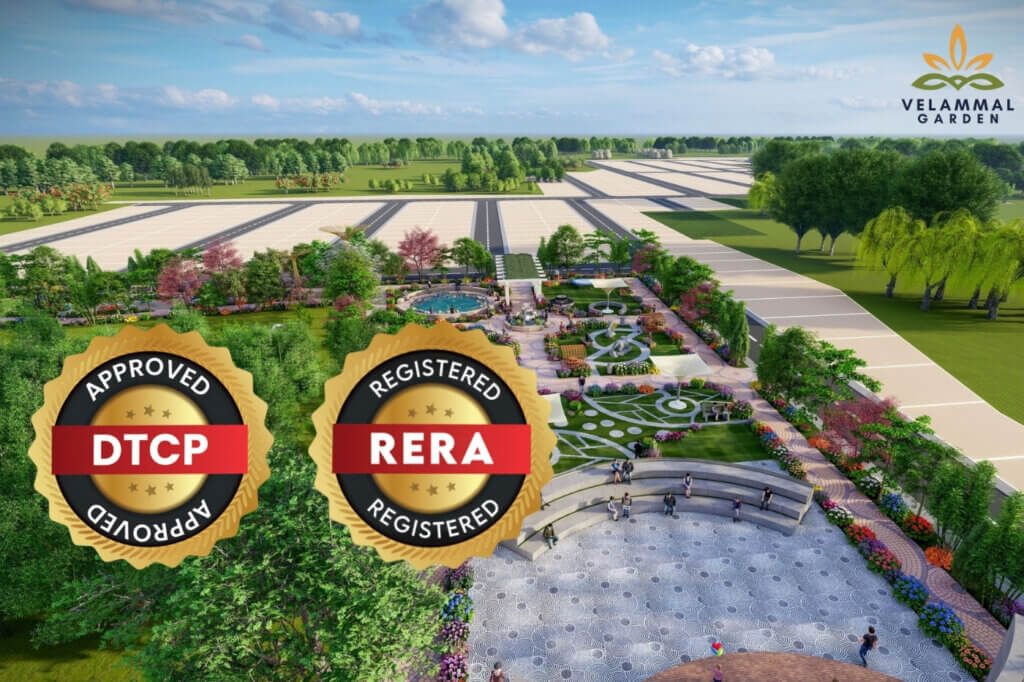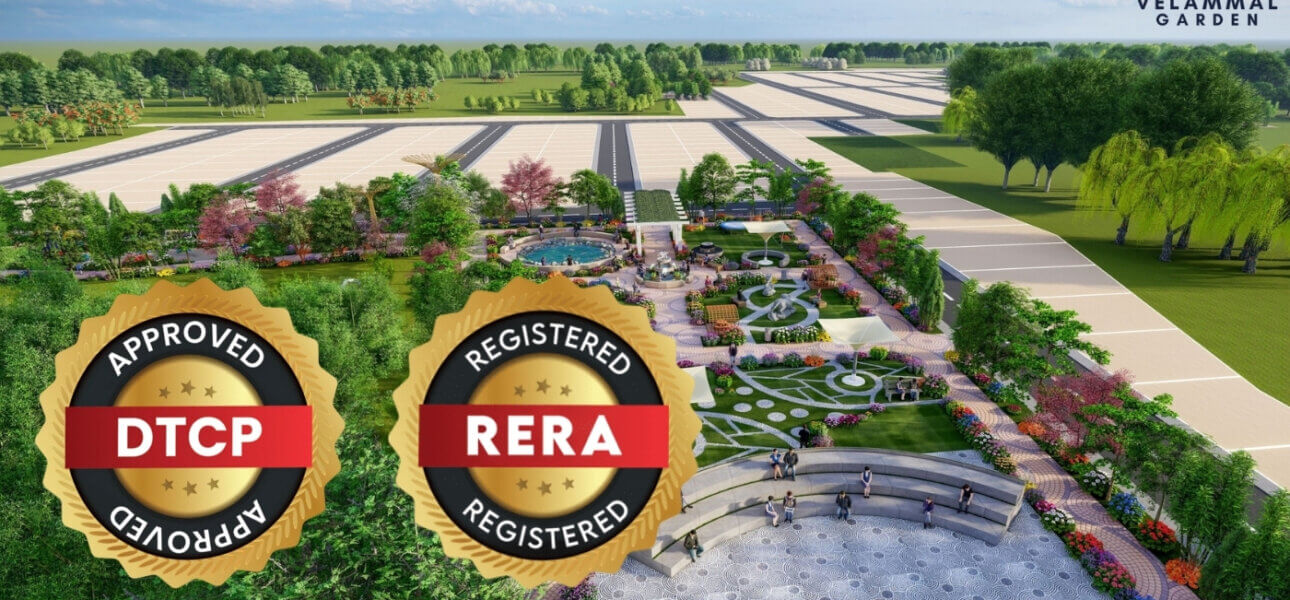Buying a plot is exciting, but tiny clauses on the layout plan can decide how smoothly you enjoy that property later. Easements and Right of Way define who can pass, access, or use parts of land for common needs like roads, drainage, water lines, and power. Learn how these work in DTCP and RERA approved layouts in Tamil Nadu so that your investment in Padappai or the Oragadam belt stays peaceful and future ready.

What do easements actually mean
An easement is a legal right for someone other than the landowner to use a portion of land for a specific purpose. It does not transfer ownership. It only allows limited use.
Common types you will see in plotted layouts:
- Access easement for internal roads and cul de sacs
- Utility easement for water lines, sewer, storm water, EB cables
- Drainage easement along the edge of plots
- Right to light and air in dense neighbourhoods
- Pedestrian access to parks or public amenities
In a DTCP approved layout, many of these are already reserved on the sanctioned plan. In a RERA registered project, they must also be declared in marketing and agreement documents.
Right of Way vs easement
Right of Way is a type of easement that specifically allows movement across land. In plotted communities it usually covers:
- Main approach from public road to your gated layout
- Internal layout roads shown on the approval drawing
- Pathways to amenities like parks and STP areas
You do not own the Right of Way area. You share the right to use it with other plot owners and with the layout association for maintenance.
Where do you spot them on a plan
Look at three places before you book:
- The DTCP sanctioned layout drawing with legend for roads, parks, OSR and utility corridors
- The RERA registration details and annexures
- Your sale deed schedule with boundaries, measurements, and any covenants
Ask the sales team to point out all marked easements on the master plan. At velammalgarden.com you will always find clarity on approvals and layout structure so you can verify before site visit.
Why easements protect your peace
Easements are not restrictions alone. They are safeguards that:
- Keep access open even if neighbouring owners change
- Prevent accidental construction over underground utilities
- Reduce disputes on parking, gate placement, or drainage
- Ensure emergency vehicle movement inside the layout
- Preserve long term value by keeping the layout functional
Typical easement areas inside a plot
Depending on the plot edge and design, you may encounter:
- A slim strip along the front boundary for utilities or road widening line
- A side or rear margin for storm water or sewer line passage
- Corner splay at junctions for safe turning and visibility
- Electric transformer set back within a dedicated common space near your street
These spaces are not for permanent structures. Fences, compound walls, or landscaping should respect the easement width and access requirement.
Setbacks, OSR and common areas
Setbacks are different from easements. Setbacks belong to you but you must keep them open as per local building rules when you construct. OSR is Open Space Reservation for parks or community spaces as per DTCP norms. Both are part of healthy planning.
Remember:
- Setbacks protect ventilation, light, and safety
- OSR remains common for all residents
- Easements may run inside setbacks or along common edges
What to check during a Padappai site visit
Carry this quick checklist:
- Are internal roads and turning radii implemented as per the approved drawing
- Are roadside drains and culverts ready and connected to a legal outfall
- Where are the EB and water utility corridors routed
- Are corner splays and junction triangles kept clear
- Are boundary stones and plot measurements matching the plan on paper
- Does the approach road from public street to the gate reflect Right of Way on title
If you are visiting Velammal Garden in the Padappai Oragadam belt, ask for the DTCP approval drawing, RERA registration details, and utility layout. The team will show you how access and services are planned for long term comfort. Explore more at velammalgarden.com before you visit.
Document clauses to insist on
For a secure transaction at the MOFU or BOFU stage, request:
- Clear mention of Right of Way over internal roads for all plot owners
- Confirmation that utilities passing through plots are recorded as non exclusive easements
- Maintenance responsibility for roads, drains, streetlights until association handover
- No objection clauses for repair access to underground lines
- Restriction on building permanent structures over marked easements
Common mistakes to avoid
- Ignoring a thin line on the edge of the plot that actually denotes a drain easement
- Assuming you can close or gate a common passage next to your boundary
- Planting trees with deep roots over sewer lines that later cause blockages
- Building a shed over an EB cable route flagged by the developer
How associations manage easements
After handover, the Residents Welfare Association usually:
- Maintains roads, streetlights, storm water paths, and OSR parks
- Coordinates repair works with utility providers
- Enforces community rules to prevent encroachment on Right of Way
- Keeps records of approvals, drawings, and as built changes
In well planned communities like Velammal Garden, clear drawings and standard operating practices make association work easier. Visit velammalgarden.com to understand how community facilities are designed with future maintenance in mind.
Practical tips while designing your home
- Share the utility map with your architect before finalising the building footprint
- Keep access chambers for sewer and water within reachable zones
- Use pavers or removable finishes over zones that may need future excavation
- Place heavy structures like sump and compound wall outside utility corridors
- Get written NOC from the association if any temporary work impacts a common passage
When to consult a professional
Speak to a real estate lawyer or architect if:
- The title mentions an old private pathway used by neighbours
- The approved plan shows a drain or duct crossing your plot
- You plan to realign a gate or driveway that meets a Right of Way
- You need clarity on maintenance liability for a corner drain or culvert
Final word
Easements and Right of Way look technical but they are simply rules that keep everyone’s movement and utilities hassle free. Choose DTCP and RERA backed layouts, read drawings closely, and record easements properly in your documents. That is how you protect your lifestyle and your ROI in the growing Padappai Oragadam corridor.
FAQs
What is an easement in a DTCP layout
An easement is a legal right to use part of land for a specific purpose like access or utilities. In DTCP approved layouts it is usually shown on the sanctioned plan and carried forward into your sale deed.
How is Right of Way different from road ownership
Right of Way allows movement across the marked road or passage but does not give you ownership of that strip. Ownership remains with the developer or association as per the layout structure while every plot owner has the right to use it.
Can I build over a drainage or utility easement
Avoid permanent structures. You may use soft landscaping or pavers but keep the route accessible for inspection and repairs. Encroaching can cause service issues and disputes with the association.
Do RERA registered projects disclose easements
Yes. RERA expects transparent disclosure of layout features and common areas. Ask for annexures that show roads, OSR, and utility corridors so that your agreement reflects these details clearly.
What should I verify before booking in Padappai
Check the DTCP approval drawing, RERA details, utility map, approach road continuity, and that all easements are respected on ground. Projects like Velammal Garden make these documents easy to review and help you buy with confidence.


